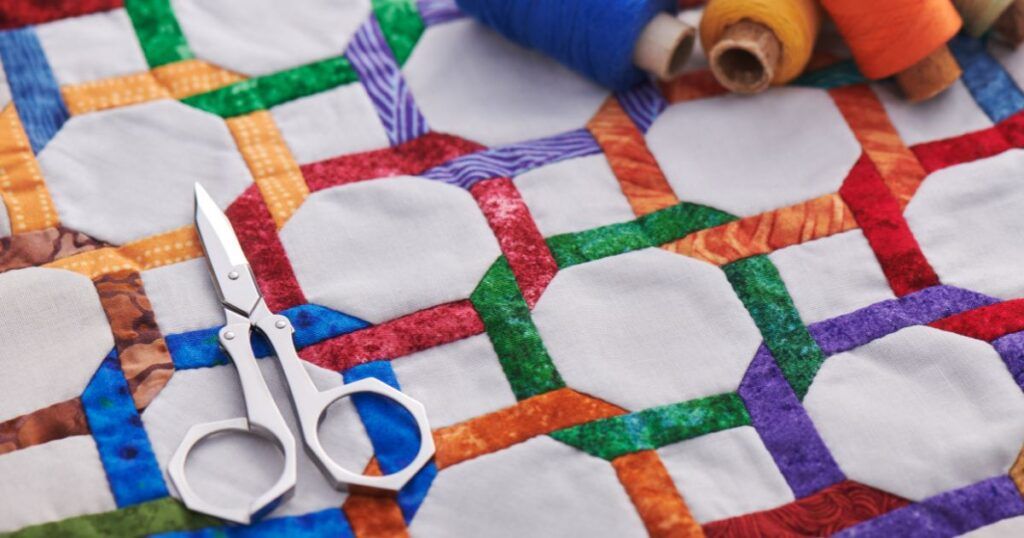Top 3 Sewing Machine Maintenance Tips for Quilters

As we delve into fall, winter, and holiday quilting, it’s important that the tools that we’re working with on a daily basis – namely our trusty sewing machines – are in tip-top condition. This means a bit of seasonal sewing machine maintenance is in order. And lucky for you, we have an entire editorial team that has published over 4,000 quilt patterns, has over 286 years of combined quilting experience, and has made more than 1,275 quilts as a team at your disposal. They know a thing or two about quilting and sewing machine maintenance. Here are their top 3 sewing machine maintenance tips for quilters.
#1 Pre-wind Your Bobbins
There’s nothing worse than running out of thread mid-way through a project. It always seems to happen at the worst possible moment and can interrupt your momentum. But wait! To keep your sew-jo on track, pre-wind enough bobbins (plus one extra!) to minimize the stopping and starting. An extra benefit? You’ll be sew glad you did!
– Vivika DeNegre

#2 Clean Under the Throat Plate
Sewing, in general—and quilting, in specific—creates lots of fuzzy lint in your machine. Working with natural materials like cotton—in fabrics, thread, and batting—are particularly ‘fuzz’ inducing. Time to clean!
You know that soft nylon brush that came with your sewing machine? If you don’t already know, this is the most useful tool for cleaning lint from under the throat plate and in the bobbin area of your sewing machine! (Tip: If you don’t have one, pipe cleaners or dry cotton swaps can be used.)
Here’s now: First, unplug your machine to prevent any chance of injury. Next, since every machine is a little different, be sure to read your manual before starting to clean. For my machine, I remove the presser foot and needle first and then pop off the throat plate to reveal the feed dogs and some of the other inner workings of the machine. I also open the bobbin compartment and remove the bobbin case.
Chances are, there’s lots of lint in and around the feed dogs and in this part of the machine. Use the brush to carefully remove the lint, using it more as a ‘pick up’ tool rather than brushing vigorously (which will cause the lint to fly around and probably land back down in the machine). I usually remove as much lint as I can from around the feed dogs area before moving to the bobbin area. Shine a light source into the bobbin cavity to see if there is any lint, stray or broken threads, etc. and carefully brush around the area. A tweezer comes in handy for thread bits that may be lodged in the mechanism.
DO NOT blow into the machine with your breath or a can of pressurized air or anything. This can lodge lint within the machine’s delicate inner workings and/or add moisture that is not good for the machine. Note: Yes, a machine repair person may use canned air from time to time, but they are trained professionals so respect their skills.
If your machine manual recommends regular oiling, now may be a good time to do so. Be sure to only use sewing machine oil, however, which is different from other machine oils. (BTW, if the oil you have is gooey or thick, it is too old. Trash it and buy new; a small investment vs. replacing your whole machine, right?!) Happy cleaning!
-Kristine Lundblad

#3 Replace Your Needles
Replacing the needle every 6-10 hours is commonly recommended. But it may be difficult to keep track of sewing time—unless you are at your machine 6-10 hours a day. Instead, replace the needle after using up 3 full bobbins. Replace the needle sooner if you start hearing a thumping noise with each stitch or your machine starts sucking in your fabric through the throatplate. Needles are so easy to replace and much less expensive than costly sewing machine repairs!
-Eileen Fowler
These are our top sewing machine maintenance tips, what are yours? And if you’re looking for more sewing machine tips make sure to check out our 8 Sewing Machine Tips the Experts Want You to Know blog post, it’s full of sewing machine gold!





On replacing your needles, Many people do not know that you can buy needles in bulk instead of buying just 5 or 6 in a package hanging in a store . Schmetz.com allows you to order bulk packs of 100 of the particular needle you use for much less than buying them that was from suppliers of sewing notions. I have bought two packs that way. the package is small so that it will fit right into your sewing box or storage container, they come with a piece or two of anti rust paper in the pack. Check it out if you are an avid sewer /quilter. Oh and by the way , the last time i ordered that way they paid the shipping costs. FREE Shipping (contiguous USA only) on:
Carded Household Needles
Bulk Household Needles
Loose Pack Needles
Industrial Needles (excluding Special-Order Needles)
Carded Bobbins
Carded Feet
Spring Needles
Buttonhole Cutter Sets
Iris “Super Fine” Pins
Gold Replacement Rotary Cutter Blades
Grabbit® Sewing Tools
Sew Essentials
SCHMETZ Scissors